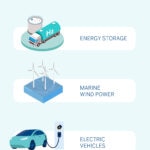The cleantech ecosystem is advancing at different rates. While technologies such as solar and wind power are already consolidated, innovations such as carbon capture and green hydrogen still have a long way to go. Reaching the maturity of these solutions is key to sustainability and requires strategic investment to accelerate global decarbonization.

The ‘cleantech’ ecosystem covers a wide range of products, services and processes in a multitude of industrial verticals. According to Cleantech for Europe, when classified by industry, cleantech can be found in agriculture and food (from regenerative agriculture to bio-based fertilizers), energy (renewables, batteries, or grid management technologies), materials and chemicals (such as alternative fuels), transportation and logistics (electric vehicles as well as sustainable planes and ships), resources and environment (carbon capture or circular economy initiatives), and enabling technologies (including artificial intelligence and quantum computing).
However, this classification does not always provide a realistic picture of the sector's level of development, as many of the proposed solutions remain little more than projects or prototypes. To this end, several analyses suggest that clean technologies should be categorized according to their level of maturity and their medium- and long-term potential. The following classification is based on data from the International Energy Agency (IEA), the European Commission, Cleantech for Europe , and the U.S. Department of Energy.
Advanced maturity: from renewable energy to batteries
"Today, solar and wind technologies are among the most mature 'cleantech' solutions and play a key role in the green transition, as they significantly reduce carbon dioxide emissions from the energy sector," says Sophia Karagianni, ‘Senior Policy Officer’ of Cleantech for Europe "Energy storage solutions, such as lithium-ion batteries, are also crucial for managing the intermittency of renewable energy sources."
According to data from the International Energy Agency, solar energy production is the fastest growing. By the end of 2023, there were 1.6 terawatts (TW) of photovoltaic capacity installed worldwide, an increase of 446 gigawatts (GW) compared to the previous year. The agency estimates that more than 30 percent of the electricity generated globally now comes from renewable sources.
With regard to energy storage, pumped-storage hydroelectric power plants (which move water to higher reservoirs during times of excess energy production and then release it when needed) remain the most common solution. However, in recent years, the deployment of large grid-connected battery systems has increased. According to the latest IEA data, more than 28 GW of battery storage is already installed, with projections to reach 1,000 GW by the end of the decade.
Other clean technologies that have already reached a high level of development and are expected to gain market share in the coming years include offshore wind power, electric vehicles (with around 40 million already on the road globally), and geothermal energy, which harnesses the high temperatures present in the Earth's inner layers.
Medium maturity: from tidal energy to green hydrogen
This category covers innovative technologies and developments at a mid-growth stage. Their boundaries are less defined—while some have only been proven in small-scale projects, others are beginning to operate at an industrial level. Included here are, among other solutions:
- Tidal power and wave energy. The first uses tidal energy, while the second taps into wave power. Though neither has been widely adopted on a large scale, both are clean technologies that have existed for years. For instance, the Rance tidal power plant in France, opened in 1966, generates 600 million kilowatt-hours annually.
- Advanced nuclear reactors. Small Modular Reactors (SMRs) have reignited interest in nuclear power in recent years. These compact, modular reactors are simpler to deploy than large power plants. The reports that 80 SMR projects are currently in development worldwide.
- Green hydrogen. Hydrogen is extensively used in industry, but over 99% is still produced from natural gas. Recently, however, interest in cleaner hydrogen production methods has grown significantly. The three main alternatives are blue hydrogen (produced from natural gas with carbon emissions captured), pink hydrogen (from water electrolysis powered by nuclear energy), and green hydrogen (produced using renewable energies). Several low-emission hydrogen production plants are currently under development in China, the European Union, India, and the United States. According to the IEA, global hydrogen production is expected to reach 38 million tons by 2030, sufficient to meet nearly half of the projected demand.

Low maturity: from green steel to alternative fuels
Finally, this group includes all the cleantech solutions that are in the early stages of development or whose deployment still depends on the ability to scale some of the technologies mentioned in the previous section. For example, this is the case with green steel and alternative aviation fuels, which to a large extent require the use of green hydrogen for their production.
One of the cleantech innovations on which the greatest hopes have been placed, despite the fact that it is at a low level of maturity, is carbon capture and storage (CCS). For the time being, the most common approach is to use technologies capable of capturing carbon dioxide at the point of production and then using it on-site in some industrial process.
According to the IEA, there are around 45 facilities of this type around the world, but they have limited capacity.
Plants solely dedicated to extracting carbon dioxide directly from the atmosphere are in a much earlier stage of development. The United States, the European Union, the United Kingdom, Canada and Japan have a few projects currently in development, most of them in the testing phase.
Another highly promising technology is solid-state batteries, which offer the potential for greater capacity, improved efficiency, lower costs, and reduced reliance on metals like lithium. These batteries are primarily designed to address the electricity storage needs of the transportation sector. Meanwhile, another innovative type of battery is being developed specifically for large-scale energy storage: molten salt batteries. There are different technologies under development and their big challenge is that they have to operate at high temperatures.
“In general, I believe that the key technologies will be those with a high potential for transforming the economy and addressing global challenges such as climate change, scarcity of resources and the energy transition”, explains Natalia Ruiz. “These include, for example, technologies for more sustainable mobility and logistics, for increasing the efficiency of renewable energies, for storing energy, for decarbonizing the industrial sector or for taking advantage of and putting waste to good use, moving us towards a circular economy.”
To achieve the climate goals outlined in the Paris Agreement, the world must be firmly on a path toward decarbonization by 2030. Clean technologies play a critical role in this journey. “We need to reduce emissions at a rate 12 times faster than we are doing now. "Clean technologies are the backbone of our climate action, but they are also the key to our competitiveness and prosperity," adds Bianca Dragomir.
